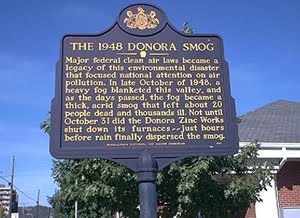
On this day in Labor History the year was 1948.
That was the day that a thick yellow fog rolled over the town of Donora, Pennsylvania just south of Pittsburgh.
Donora was a mill town, nestled in a valley on the bank of the Monongahela River.
By 1948, the town had grown to 14,000 people, who came to work in the town’s steel mills and the Donora Zinc Works.
For years the local residents had complained about the pollution that spilled from the plants.
Smog was a regular occurrence.
But this fog was even worse than usual.
A layer of cold air was trapping a noxious blend of nitrogen dioxide, sulfuric acid and fluoride pollution.
Twenty-four hours passed, and still the fog grew denser.
The police and local doctors began to receive reports of people having difficulties breathing.
The fog became so thick that residents could not see to drive.
For five days the smog hung over the town, until a rain fall began to break it up.
Nearly half of the towns’ residents became ill.
Twenty died.
U.S. Steel refused to take blame for the fog, even though they continued to run the plant as the deadly toxins continued to build.
According to a 2010 article by the Pittsburgh Post-Gazette, “Despite the efforts of industry to cast the tragedy as an “act of God,” the fatalities in Donora received national attention. The event changed the way air pollution was viewed, moving it rapidly from an aesthetic issue to a public health concern, and spurred local, state and federal officials to control toxic air pollution.”
In 2008 a Smog Museum opened with the motto “Clean Air Started Here.”
More Episodes
 2024-05-12
2024-05-12
 2024-05-12
2024-05-12
 2024-05-12
2024-05-12
 2024-05-05
2024-05-05
 2024-05-05
2024-05-05
 2024-05-05
2024-05-05
 2024-05-05
2024-05-05
 2024-05-05
2024-05-05
 2024-05-05
2024-05-05
 2024-04-28
2024-04-28
 2024-04-28
2024-04-28
 2024-04-28
2024-04-28
 2024-04-28
2024-04-28
 2024-04-27
2024-04-27
Create your
podcast in
minutes
- Full-featured podcast site
- Unlimited storage and bandwidth
- Comprehensive podcast stats
- Distribute to Apple Podcasts, Spotify, and more
- Make money with your podcast
It is Free
- Privacy Policy
- Cookie Policy
- Terms of Use
- Consent Preferences
- Copyright © 2015-2024 Podbean.com




